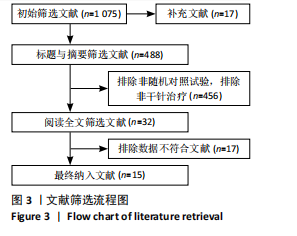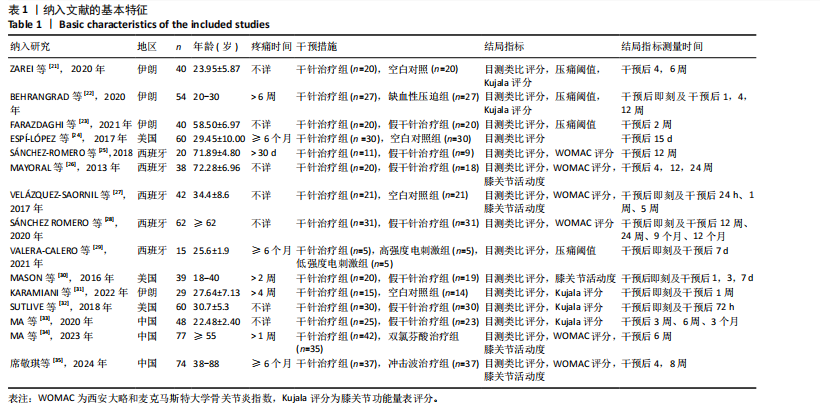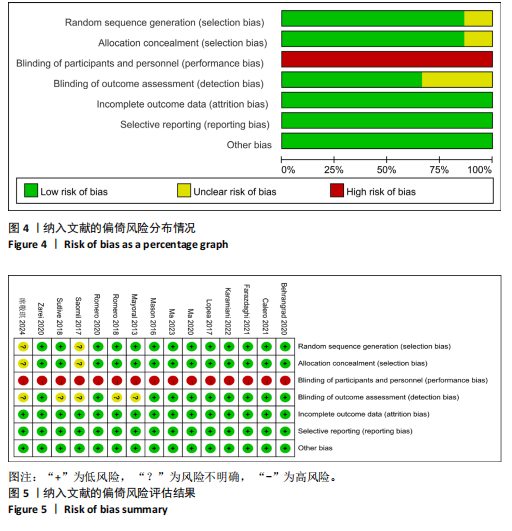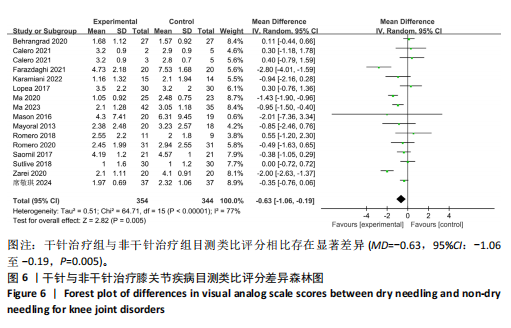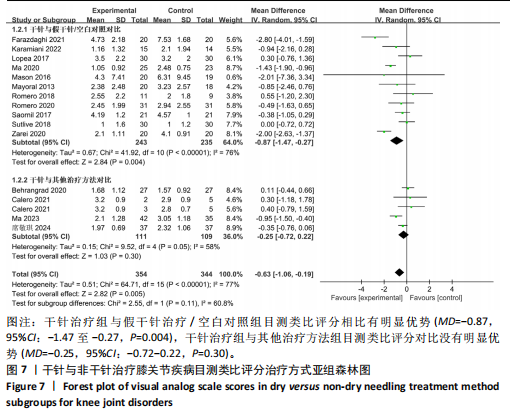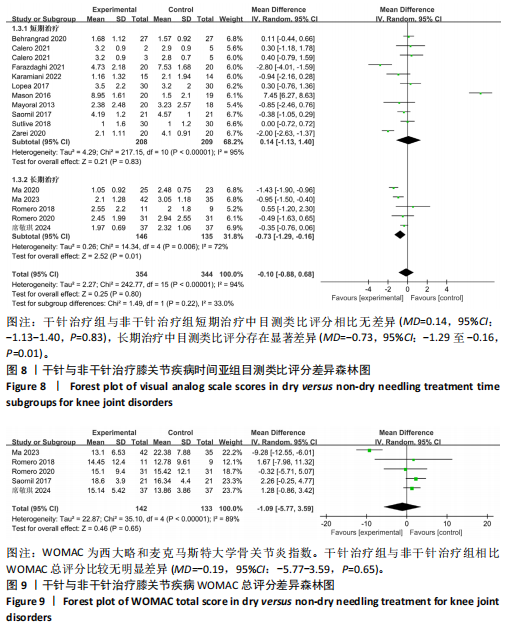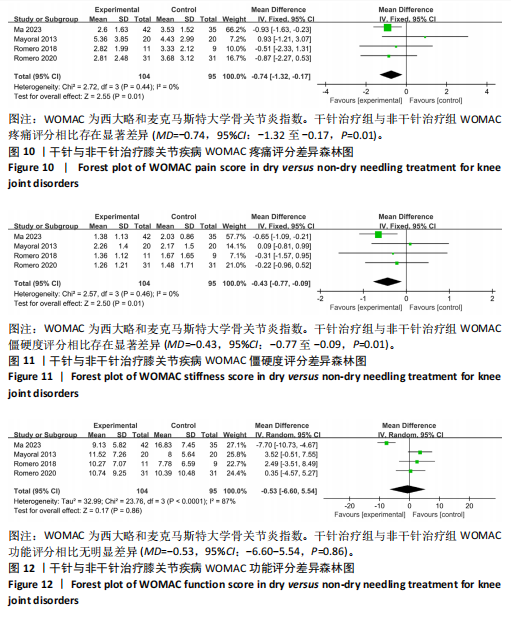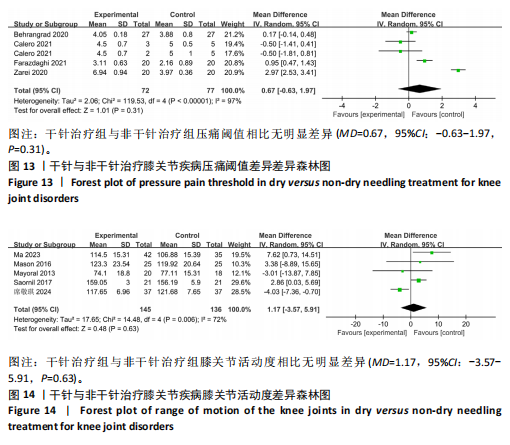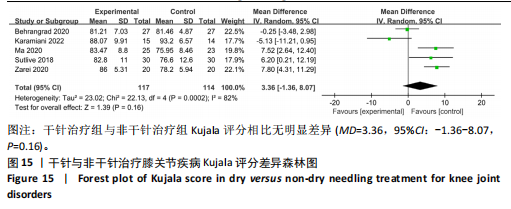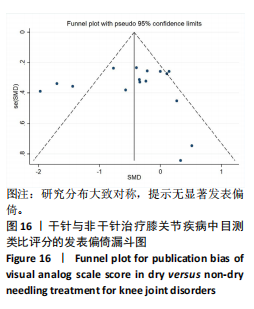[1] CHANG AH, ALMAGOR O, LEE JJ, et al. The Natural History of Knee Osteoarthritis Pain Experience and Risk Profiles. J Pain. 2023;24(12):2175-2185.
[2] SEOANE-MATO D, SÁNCHEZ-PIEDRA C, SILVA-FERNÁNDEZ L, et al. Prevalence of rheumatic diseases in adult population in Spain (EPISER 2016 study): Aims and methodology. Reumatol Clin (Engl Ed). 2019;15(2):90-96.
[3] 王声雨,林源,陶树清.中老年人膝骨关节炎的影响因素分析[J].中国医药导报,2021,18(27):80-83.
[4] MICHAEL JW, SCHLÜTER-BRUST KU, EYSEL P. The epidemiology, etiology,diagnosis, and treatment of osteoarthritis of the knee. Dtsch Arztebl Int. 2010;107(9):152-162.
[5] 吴园园,郑拥军.肌筋膜疼痛触发点在膝骨性关节炎中作用的研究进展[J].老年医学与保健,2019,25(5):679-682.
[6] BARBERO M, SCHNEEBELI A, KOETSIER E, et al. Myofascial pain syndrome and trigger points: evaluation and treatment in patients with musculoskeletal pain. Curr Opin Support Palliat Care. 2019;13(3):270-276.
[7] LIU L, HUANG QM, LIU QG, et al. Relationship between muscle spindles and myofascial trigger spots according to Hoffmann reflex pathway and tissue morphology characteristics in a rat model. Acupunct Med. 2020;38(2):109-116.
[8] LIU L, HUANG QM, LIU QG, et al. Evidence for Dry Needling in the Management of Myofascial Trigger Points Associated With Low Back Pain: A Systematic Review and Meta-Analysis. Arch Phys Med Rehabil. 2018;99(1):144-152.e2.
[9] 郑兵,朱江,吴雪莲,等.针刺肌筋膜触发点在疼痛治疗中的研究进展[J].中国康复医学杂志, 2022,37(1):117-120.
[10] FERNÁNDEZ-DE-LAS-PEÑAS C, NIJS J. Trigger point dry needling for the treatment of myofascial pain syndrome: current perspectives within a pain neuroscience paradigm. J Pain Res. 2019;12:1899-1911.
[11] 孙定炯.肌筋膜疼痛触发点与传统经络穴位异同点的思考[J].海南医学院学报,2020,26(17): 1358-1360.
[12] STOOP R, CLIJSEN R, LEONI D, et al. Evolution of the methodological quality of controlled clinical trials for myofascial trigger point treatments for the period 1978-2015: A systematic review. Musculoskelet Sci Pract. 2017;30:1-9.
[13] SZIKSZAY TM, ADAMCZYK WM, CARVALHO GF, et al. Association between myofascial trigger point therapy and conditioned pain modulation. J Bodyw Mov Ther. 2024;38:73-80.
[14] KOSZALINSKI A, FLYNN T, HELLMAN M, et al. Trigger point dry needling, manual therapy and exercise versus manual therapy and exercise for the management of Achilles tendinopathy: a feasibility study. J Man Manip Ther. 2020;28(4):212-221.
[15] RAHOU-EL-BACHIRI Y, NAVARRO-SANTANA MJ, GÓMEZ-CHIGUANO GF, et al. Effects of Trigger Point Dry Needling for the Management of Knee Pain Syndromes: A Systematic Review and Meta-Analysis. J Clin Med. 2020;9(7):2044.
[16] LIN X, LI F, LU H, et al. Acupuncturing of myofascial pain trigger points for the treatment of knee osteoarthritis: A systematic review and meta-analysis. Medicine (Baltimore). 2022;101(8): e28838.
[17] JIMÉNEZ-DEL-BARRIO S, MEDRANO-DE-LA-FUENTE R, HERNANDO-GARIJO I, et al. The Effectiveness of Dry Needling in Patients with Hip or Knee Osteoarthritis: A Systematic Review and Meta-Analysis. Life (Basel). 2022;12(10):1575.
[18] DOMMERHOLT J, HOOKS T, CHOU LW, et al. A critical overview of the current myofascial pain literature - November 2018. J Bodyw Mov Ther. 2019;23(1):65-73.
[19] FURLAN AD, MALMIVAARA A, CHOU R, et al. 2015 Updated Method Guideline for Systematic Reviews in the Cochrane Back and Neck Group. Spine (Phila Pa 1976). 2015;40(21):1660-1673.
[20] 杨晓妍,李鸿浩.知证卫生决策工具附件:评估设计的优缺点选录(文18附件3)[J].中国循证医学杂志,2010,10(6):648-649.
[21] ZAREI H, BERVIS S, PIROOZI S, et al. Added Value of Gluteus Medius and Quadratus Lumborum Dry Needling in Improving Knee Pain and Function in Female Athletes With Patellofemoral Pain Syndrome: A Randomized Clinical Trial. Arch Phys Med Rehabil. 2020;101(2):265-274.
[22] BEHRANGRAD S, ABBASZADEH-AMIRDEHI M, KORDI YOOSEFINEJAD A, et al. Comparison of dry needling and ischaemic compression techniques on pain and function in patients with patellofemoral pain syndrome: a randomised clinical trial. Acupunct Med. 2020;38(6):371-379.
[23] FARAZDAGHI M, KORDI YOOSEFINEJAD A, ABDOLLAHIAN N, et al. Dry needling trigger points around knee and hip joints improves function in patients with mild to moderate knee osteoarthritis. J Bodyw Mov Ther. 2021;27:597-604.
[24] ESPÍ-LÓPEZ GV, SERRA-AÑÓ P, VICENT-FERRANDO J, et al. Effectiveness of Inclusion of Dry Needling in a Multimodal Therapy Program for Patellofemoral Pain: A Randomized Parallel-Group Trial. J Orthop Sports Phys Ther. 2017;47(6):392-401.
[25] SÁNCHEZ-ROMERO EA, PECOS-MARTÍN D, CALVO-LOBO C, et al. Effects of dry needling in an exercise program for older adults with knee osteoarthritis: A pilot clinical trial. Medicine (Baltimore). 2018; 97(26):e11255.
[26] MAYORAL O, SALVAT I, MARTÍN MT, et al. Efficacy of myofascial trigger point dry needling in the prevention of pain after total knee arthroplasty: a randomized, double-blinded, placebo-controlled trial. Evid Based Complement Alternat Med. 2013;2013:694941.
[27] VELÁZQUEZ-SAORNIL J, RUÍZ-RUÍZ B, RODRÍGUEZ-SANZ D, et al. Efficacy of quadriceps vastus medialis dry needling in a rehabilitation protocol after surgical reconstruction of complete anterior cruciate ligament rupture. Medicine (Baltimore). 2017;96(17):e6726.
[28] SÁNCHEZ ROMERO EA, FERNÁNDEZ-CARNERO J, CALVO-LOBO C, et al. Is a Combination of Exercise and Dry Needling Effective for Knee OA? Pain Med. 2020;21(2):349-363.
[29] VALERA-CALERO JA, SÁNCHEZ-MAYORAL-MARTÍN A, VAROL U. Short-term effectiveness of high- and low-intensity percutaneous electrolysis in patients with patellofemoral pain syndrome: A pilot study. World J Orthop. 2021;12(10):781-790.
[30] MASON JS, CROWELL M, DOLBEER J, et al. The effectiveness of dry needling and stretching vs. stretching alone on hamstring flexibility in patients with knee pain: a randomized controlled trial. Int J Sports Phys Ther. 2016;11(5):672-683.
[31] KARAMIANI F, MOSTAMAND J, RAHIMI A, et al. The Effect of Gluteus Medius Dry Needling on Pain and Physical Function of Non-athlete women with Unilateral Patellofemoral Pain Syndrome: A Double-Blind Randomized Clinical Trial. J Bodyw Mov Ther. 2022;30:23-29.
[32] SUTLIVE TG, GOLDEN A, KING K, et al. Short-term effects of trigger point dry needling on pain and disability in subjects with patellofemoral pain syndrome. Int J Sports Phys Ther. 2018;13(3):462-473.
[33] MA YT, LI LH, HAN Q, et al. Effects of Trigger Point Dry Needling on Neuromuscular Performance and Pain of Individuals Affected by Patellofemoral Pain: A Randomized Controlled Trial. J Pain Res. 2020;13:1677-1686.
[34] MA YT, DONG YL, WANG B, et al. Dry needling on latent and active myofascial trigger points versus oral diclofenac in patients with knee osteoarthritis: a randomized controlled trial. BMC Musculoskelet Disord. 2023;24(1):36.
[35] 席敬琪,梁恩龙,唐玉萍,等.发散式体外冲击波结合肌筋膜触发点针刺治疗膝骨关节炎疗效观察[J]. 现代中西医结合杂志,2024,33(10): 1364-1369. |
